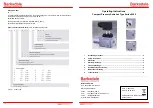
Managing Device Information
Configuring SNTP
Page 55
Configuring SNTP
The device supports the
Simple Network Time Protocol
(SNTP). SNTP assures accurate network device clock
time synchronization up to the millisecond. Time synchronization is performed by a network SNTP server. The
device operates only as an SNTP client, and cannot provide time services to other systems. The device can poll
the following server types for the server time:
•
Unicast
•
Anycast
•
Broadcast
Time sources are established by stratums. Stratums define the accuracy of the reference clock. The higher the
stratum (where zero is the highest), the more accurate the clock. The device receives time from stratum 1 and
above.
The following is an example of stratums:
•
Stratum 0
— A real time clock (such as a GPS system) is used as the time source.
•
Stratum 1
— A server that is directly linked to a Stratum 0 time source is used. Stratum 1 time servers pro-
vide primary network time standards.
•
Stratum 2
— The time source is distanced from the Stratum 1 server over a network path. For example, a
Stratum 2 server receives the time over a network link, via NTP, from a Stratum 1 server.
Information received from SNTP servers are evaluated based on the Time level and server type. SNTP time defi-
nitions are assessed and determined by the following time levels:
•
T1
— The time at which the original request was sent by the client.
•
T2
— The time at which the original request was received by the server.
•
T3
— The time at which the server sent the client a reply.
•
T4
— The time at which the client received the server's reply.
Polling for Unicast Time Information
Polling for Unicast information is used for polling a server for which the IP address is known. T1 - T4 are used to
determine the server time. This is the preferred method for synchronizing device time.
Polling for Anycast Time Information
Polling for Anycast information is used when the server IP address is unknown. The first Anycast server to return
a response is used to set the time value. Time levels T3 and T4 are used to determine the server time. Using Any-
cast time information for synchronizing device time is preferred to using Broadcast time information.
Broadcast Time Information
Broadcast information is used when the server IP address is unknown. When a broadcast message is sent from
an SNTP server, the SNTP client listens for the response. The SNTP client neither sends time information
requests nor receives responses from the Broadcast server.
Message Digest 5
(MD5) Authentication safeguards device synchronization paths to SNTP servers. MD5 is an
algorithm that produces a 128-bit hash. MD5 is a variation of MD4, and increases MD4 security. MD5 verifies the
integrity of the communication, and authenticates the origin of the communication.
Содержание DES-3252P - Web Smart Switch
Страница 1: ......
Страница 271: ...Appendix C Technical Support Contacting D Link Technical Support Page 271 ...
Страница 272: ...Appendix C Technical Support Contacting D Link Technical Support Page 272 ...
Страница 273: ...Appendix C Technical Support Contacting D Link Technical Support Page 273 ...
Страница 274: ...Appendix C Technical Support Contacting D Link Technical Support Page 274 ...
Страница 275: ...Appendix C Technical Support Contacting D Link Technical Support Page 275 ...
Страница 276: ...Appendix C Technical Support Contacting D Link Technical Support Page 276 ...
Страница 277: ...Appendix C Technical Support Contacting D Link Technical Support Page 277 ...
Страница 278: ...Appendix C Technical Support Contacting D Link Technical Support Page 278 ...
Страница 279: ...Appendix C Technical Support Contacting D Link Technical Support Page 279 ...
Страница 280: ...Appendix C Technical Support Contacting D Link Technical Support Page 280 ...
Страница 281: ...Appendix C Technical Support Contacting D Link Technical Support Page 281 ...
Страница 282: ...Appendix C Technical Support Contacting D Link Technical Support Page 282 ...
Страница 283: ...Appendix C Technical Support Contacting D Link Technical Support Page 283 ...
Страница 284: ...Appendix C Technical Support Contacting D Link Technical Support Page 284 ...
Страница 285: ...Appendix C Technical Support Contacting D Link Technical Support Page 285 ...
Страница 286: ...Appendix C Technical Support Contacting D Link Technical Support Page 286 ...
Страница 287: ...Appendix C Technical Support Contacting D Link Technical Support Page 287 ...
Страница 288: ...Appendix C Technical Support Contacting D Link Technical Support Page 288 ...
Страница 289: ...Appendix C Technical Support Contacting D Link Technical Support Page 289 ...
Страница 290: ...Appendix C Technical Support Contacting D Link Technical Support Page 290 ...
Страница 291: ...Appendix C Technical Support Contacting D Link Technical Support Page 291 ...
Страница 292: ...Appendix C Technical Support Contacting D Link Technical Support Page 292 ...
Страница 293: ...Appendix C Technical Support Contacting D Link Technical Support Page 293 ...
Страница 294: ...Appendix C Technical Support Contacting D Link Technical Support Page 294 ...
Страница 295: ...Appendix C Technical Support Contacting D Link Technical Support Page 295 ...
Страница 296: ...Appendix C Technical Support Contacting D Link Technical Support Page 296 ...
















































